
You use a Magnetic Stripe Card Reader to get data from the black stripe on cards. These cards can be credit cards or employee badges. This device lets you pay for things, open doors, or check in for travel. You find them in stores, offices, and buses. Knowing how these readers work helps you pick the right one and use it safely.
This article will walk you through everything you need to know about magnetic stripe card readers, including how they work, their types, interfaces, advantages, and real-world use cases.
Key Takeaways
Magnetic Stripe Card Readers get data from the black stripe on cards. This lets people pay fast and helps control who can enter places.
Pick a magstripe reader by looking at how it connects, if it works with your systems, and what security it has. This helps keep payments safe.
Know the difference between Low-Coercivity (LoCo) and High-Coercivity (HiCo) cards. This helps you pick the right card for what you need.
Check your card reader often and update it. This helps stop skimming and keeps your reader safe from other dangers.
Think about where you will use the reader. Some readers work better in busy places or outside.
Basics of Magnetic Stripe Card Readers

What Is a Magnetic Stripe Card Reader
A Magnetic Stripe Card Reader reads the black stripe on cards. This stripe has important details like account numbers or access rights. A magnetic stripe reader is a device that reads data on the stripe. The stripe is a layer of magnetic stuff on a plastic card. You cannot save or write new data with the reader. It only reads what is already on the card.
When you swipe your card, the reader gets the data from the stripe. People use these readers for credit cards, badges, or bus passes. The device helps you pay, open doors, or check in for trips. You see Magnetic Stripe Card Readers in many places. They make using cards fast and simple.
How It Works
You can learn how a Magnetic Stripe Card Reader works by looking at its steps. First, you swipe or insert your card. The card moves past a read head inside the reader. The read head senses changes in the magnetic field. It turns these changes into an electric signal.
The reader changes this signal into digital data. Then it sends the data to a computer or terminal. Next, the system checks the data in a database. If the data matches, you get access or your payment works.
Here is a simple list of the steps:
Swiping or Inserting the Card: You move the card through the reader.
Reading the Magnetic Data: The read head senses the magnetic changes.
Decoding and Transmitting the Data: The reader changes the signal into digital data and sends it to a system.
Authentication and Response: The system checks the data and gives you access or approves your payment.
Tip: You do not need special skills to use most Magnetic Stripe Card Readers. Many models work with a simple swipe or insert, making them user-friendly.
You may wonder what kind of data the reader gets from your card. The magnetic stripe has three tracks. Each track keeps different information. The table below shows what each track does:
Track Number | Function Description |
|---|---|
Track 1 | Holds letters and numbers, mostly for money transactions. |
Track 2 | Holds numbers, often used in banks and security. |
Track 3 | Holds extra security details, but is not used much. |
You use these tracks every time you swipe your card. The reader gets the right data for your payment or access.
Types of Magnetic Stripe Reader
Interface Types: USB, RS232, and TTL

You can connect magnetic stripe card readers to computers and other devices in different ways. The most common interfaces are USB, RS232, and TTL. Each type has its own strengths.
Interface Type | Key Features | Typical Use Cases |
|---|---|---|
USB | Plug-and-play, easy to use, works with most computers, no extra software needed | Retail stores, offices, schools |
RS232 | Good for older systems, stable connection, often used in industrial settings | Kiosks, gaming machines, petrol stations |
TTL | Simple design, fits in small spaces, used in custom electronics | ATMs, custom kiosks, embedded systems |
You might see USB magnetic stripe reader in stores because they are easy to set up. RS232 readers work well with older equipment. TTL readers fit inside small machines or special projects.
Tip: Many readers have LED lights. These lights show if your card swipe worked or not. This makes using the reader simple and clear.
Some readers can read cards in both directions. This feature helps you use the reader faster and with fewer errors. Most readers last for over 1,000,000 swipes, so you can trust them in busy places.
By Card Type (Magnetic Stripe Type)
Magnetic stripe cards come in two main types: Low-Coercivity (LoCo) and High-Coercivity (HiCo). The type you choose depends on how you plan to use the card.
Type | Coercivity (Oe) | Appearance | Durability | Typical Uses |
|---|---|---|---|---|
LoCo | 0 – 300 | Brown Stripe | Easier to erase, less durable | Hotel keys, transit passes, gift cards |
HiCo | 300 – 3000 | Black Stripe | Harder to erase, more durable | Credit cards, employee IDs, access cards |
LoCo cards low coercivity magnetic stripes are easy to write and erase. You find them in hotels and transit systems. These cards work well for short-term use.
HiCo cards high coercivity magnetic stripes store more data and resist wear. You use them for bank cards and employee badges. These cards last longer and keep your data safe.
Note: HiCo cards need a stronger magnetic field to write data. This makes them better for cards you use every day.
You also find three tracks on each card. Track 1 holds your name and account number. Track 2 keeps your account number and expiration date. Track 3 stores extra data but is not used as much. Each track helps the reader get the right information for your needs.
Uses and Applications

Retail and Payments
You see Magnetic Stripe Card Readers in almost every store. These devices help you pay with credit cards, debit cards, and even gift cards. Many shops use them for loyalty programs, letting you earn points or get discounts when you swipe your loyalty card. You also find them in places that sell gift cards or use customer cards for rewards. Employees use special cards to clock in or unlock doors.
Here is a table showing common uses in retail:
Use Case | Description |
|---|---|
Credit/Debit Cards | Use debit and credit transactions to pay for items quickly and safely. |
Gift Cards | Makes it easy for stores to accept and process gift cards. |
Customer Cards | Helps you join loyalty programs and get rewards. |
Loyalty Cards | Tracks your purchases and gives you discounts. |
Employee Cards | Used for staff identification and access control. |
Most readers offer plug-and-play features. You can set them up without special skills. High-volume performance means they work well even in busy stores.
Access Control
You use Magnetic Stripe Card Readers for access control in offices, schools, and secure areas. These readers let you swipe or insert your card to open doors or check in. The process is simple:
You swipe or insert your card.
The reader detects the magnetic data.
It sends the data to a computer system.
The system checks if you have permission and then lets you in.
Security features matter in access control. Look at this table to see what you should know:
Security Feature | Description |
|---|---|
Cloning Vulnerability | Cards are easy to copy. |
Physical Damage | Cards can get damaged or lose data. |
Encryption | No encryption, so data is not protected. |
Data Storage | Only a small amount of data fits on the card. |
You should use these readers in places where you need quick entry but do not need high security.
Access Control Applications

You find Magnetic Stripe Card Readers in buses, subways, and trains. These readers help you pay fares and enter stations fast. Many older transit systems still use them because they work well and cost less than new technology.
Here is how they help in transportation:
You pay your fare by swiping your card.
The reader checks your card and lets you board quickly.
Transit systems use these readers to collect money and track riders.
Durability and compatibility matter in busy stations. Readers must handle many swipes each day and work with different card types. They read all tracks on the card to avoid errors and keep lines moving.
Tip: Magnetic Stripe Card Readers make travel easier for everyone, especially during rush hour.
Magnetic Stripe Card Reader Types
You can see different card readers in many places. Stores, offices, and public spots use them. Each type works in its own way. Each one is good for certain jobs. The table below lists the main types you might find:
Type of Reader |
|---|
Standalone Readers |
Embedded Readers |
Mobile Readers |
Integrated Systems |
Swipe Readers
Swipe readers have a slot for your card. You move your card through the slot. These readers help you pay or get in fast. Many stores and buses use swipe readers. You only need to swipe your card once.
Swipe readers have some problems. If you swipe too fast, it may not work. If you swipe too slow, it may miss the data. The table below shows how swipe readers and insertion readers are different:
Aspect | Swipe Readers | Insertion Readers |
|---|---|---|
Reliability | Sometimes do not work well | Works better at some registers |
User Experience | Fast but not very safe | Safer with chip and PIN |
Maintenance | Needs less care | Needs more checks and updates |
Swipe readers are simple to use. But they do not keep your data safe. Many banks and stores now use other readers. Swipe readers are not as safe as new types.
Note: Swipe readers are old now. Try to use machines with chip and PIN for better safety.
Insertion Readers
Insertion readers need you to put your card inside. You leave your card in until it is done. These readers work with chip cards. You see them in banks, hotels, and safe offices.
Insertion readers give you more safety. They use chip and PIN to keep your data safe. This method uses special codes to protect your info. EMV machines help stop people from stealing your data.
Insertion readers give you better safety.
You should check and update these readers often.
Mobile and USB Readers
Mobile and USB readers connect to phones or computers. You use them for payments anywhere. Small shops and events use mobile readers. Many mobile readers plug into your phone and use apps. USB readers are easy to set up on computers.
You can take mobile readers with you. They help you take payments at markets or events. USB readers are good for desktops and laptops. Both types are easy to use and set up fast.
Tip: Pick a Magnetic Stripe Card Reader that fits your needs. Mobile and USB readers help you work anywhere and serve more people.
Choosing a Reader
Key Factors
You need to pick the best Magnetic Stripe Card Reader for your needs. First, look at what matters most.
Connectivity Options: Pick a reader that connects with Bluetooth, USB, 4G, or Wi-Fi. This helps you use it with your business setup.
Compatibility with POS Systems: Make sure your reader works with your cash register or computer. Some readers work with Android, iOS, or Windows.
Security Compliance: Choose a reader that meets PCI-DSS rules and is EMV certified. This keeps your data safe.
Ease of Use: Pick a device your staff can use easily.
Cost and Maintenance: Think about the price and how much it costs to keep it working.
You can find readers for many budgets. Some cost about $10, but some cost $173 or more. Look for features that fit your business, like plug-and-play or high-volume use.
Type of Reader | Features Included | |
|---|---|---|
Mobile Card Readers | $40 – $60 | Basic functions for small payments |
Handheld Terminals | $300 – $400 | Portable, longer battery life |
Countertop Terminals | $700 – $900 | Full POS features, extra options |
Lower-tier Readers | Free with account | Basic reading, limited functions |
Tip: Think about where you will use your reader. Some models work better outside or in busy places.
Compatibility
Your card reader must work with your current systems. Check if the reader matches your POS, computer, or software. If you use Android, iOS, or Windows, make sure the reader supports your system.
Factor | Description |
|---|---|
Compatibility | Works with your POS, computer, or software. |
Some readers let you change settings. You can pick which tracks to read and set power options. These features help you use the reader in many places, inside or outside.
Security
Security is important when you use card readers. Thieves may try to steal card data with skimming devices. These can hide inside or outside the reader and copy your card info. You could lose money or have your identity stolen.
To stay safe, do these things:
Check your card reader for broken seals or odd parts.
Use bank-owned or indoor ATMs.
Set up alerts for your account.
Try contactless payments or EMV chip cards.
New readers have extra safety features. You can use indicator lights, beep sounds, and special relays. Some readers work in very hot or cold places and have network options for better control.
Note: Always check your reader and update its software. This helps keep your business and your customers safe.
You make better choices when you know about different magnetic stripe card readers. Many readers are easy to set up and do not cost much. But they can have security problems and may not get updates in the future.
Feature | Description |
|---|---|
These readers work with most cards. | |
Low cost | They are good for new or small businesses. |
Security risks | Cards can be copied, so fraud is possible. |
Future use | They are still good for backup or small jobs. |
Think about what you need for safety, what works with your system, and how much you can spend before you buy. More people around the world use magnetic access cards every year, so you need to pick carefully.
Some readers are better for busy stores or big companies.
You choose the best reader when you match it to your business needs.
FAQ
What is the difference between HiCo and LoCo magnetic stripe cards?
Type | Durability | Common Use |
|---|---|---|
HiCo | High | Credit cards, IDs |
LoCo | Low | Hotel keys, passes |
HiCo cards last longer and resist damage. LoCo cards work for short-term needs.
Can you use a magnetic stripe card reader with any computer?
You can use most data capture device with Windows, Mac, or Linux. USB readers work best for plug-and-play. Always check the reader’s compatibility before you buy.
How do you keep your card reader safe from skimming?
Tip: Check your reader for loose parts or strange devices. Use indoor machines when possible. Update your reader’s software often to block new threats.
Why does my card sometimes not work in the reader?
Dirty or damaged stripes cause errors. Swipe your card slowly and keep it clean. If problems continue, try another card or reader.
Do magnetic card readers store your card data?
Magnetic stripe card readers do not store your card data. They only read and send information to the system. Your card details stay safe if you use trusted readers.
How does a magnetic stripe card reader track employee time and attendance?
Each employee is issued a magnetic stripe card containing a unique ID.
When the card is swiped through the reader:
The reader decodes the card ID.
The data is sent to a time and attendance system or software.
The software logs the check-in or check-out time automatically.
This eliminates the need for paper sign-ins and ensures accurate attendance data.

